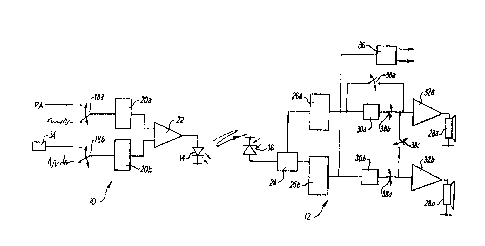Some of the information on this Web page has been provided by external sources. The Government of Canada is not responsible for the accuracy, reliability or currency of the information supplied by external sources. Users wishing to rely upon this information should consult directly with the source of the information. Content provided by external sources is not subject to official languages, privacy and accessibility requirements.
Any discrepancies in the text and image of the Claims and Abstract are due to differing posting times. Text of the Claims and Abstract are posted:
| (12) Patent Application: | (11) CA 2171902 |
|---|---|
| (54) English Title: | INFRA RED COMMUNICATION SYSTEMS |
| (54) French Title: | SYSTEME DE COMMUNICATION INFRAROUGE |
| Status: | Deemed Abandoned and Beyond the Period of Reinstatement - Pending Response to Notice of Disregarded Communication |
| (51) International Patent Classification (IPC): |
|
|---|---|
| (72) Inventors : |
|
| (73) Owners : |
|
| (71) Applicants : |
|
| (74) Agent: | SMART & BIGGAR LP |
| (74) Associate agent: | |
| (45) Issued: | |
| (22) Filed Date: | 1996-03-15 |
| (41) Open to Public Inspection: | 1997-09-16 |
| Availability of licence: | N/A |
| Dedicated to the Public: | N/A |
| (25) Language of filing: | English |
| Patent Cooperation Treaty (PCT): | No |
|---|
| (30) Application Priority Data: | None |
|---|
A transmitter (10) and one or more receivers (12) are
linked by infra red transmission via LED (14) and
photodiode (16). In normal use, in-flight entertainment
is modulated on left and right channels to give stereo
sound on a user's earphones (28a, 28b). Transmitter
public address signal on one channel and a code signal
on the other channel. At the receiver (12), the code is
detected (at 36) to operate receiver switching means
(38) which disable the user's volume controls (30),
thus ensuring that the public address message is heard
at full volume. Also described are improved infrared
signal receiving arrangements mitigating the effects of
ambient light interference.
Émetteur (10) et un ou plusieurs récepteurs (12) liés par rayons infrarouges au moyen de DEL (14) et photodiodes (16). Normalement, le système de divertissement de bord est modulé sur des voies gauche et droite pour produire un effet stéréophonique sur les écouteurs d'un utilisateur (28a, 28b). Il émet un signal d'annonce sur un canal et un signal de code sur l'autre. Le récepteur (12) détecte le code (au point 36) afin de mettre en marche un dispositif de commutation (38) qui rend inopérantes les commandes de volume de l'utilisateur (30) et permet ainsi l'audition de l'annonce à plein volume. On présente également des moyens améliorés de réception des signaux infrarouges, qui atténuent les effets d'interférences lumineuses ambiantes.
Note: Claims are shown in the official language in which they were submitted.
Note: Descriptions are shown in the official language in which they were submitted.

2024-08-01:As part of the Next Generation Patents (NGP) transition, the Canadian Patents Database (CPD) now contains a more detailed Event History, which replicates the Event Log of our new back-office solution.
Please note that "Inactive:" events refers to events no longer in use in our new back-office solution.
For a clearer understanding of the status of the application/patent presented on this page, the site Disclaimer , as well as the definitions for Patent , Event History , Maintenance Fee and Payment History should be consulted.
| Description | Date |
|---|---|
| Inactive: IPC deactivated | 2013-11-12 |
| Inactive: First IPC assigned | 2013-02-19 |
| Inactive: IPC assigned | 2013-02-19 |
| Inactive: IPC assigned | 2013-02-19 |
| Inactive: IPC expired | 2013-01-01 |
| Inactive: Dead - RFE never made | 2004-03-15 |
| Application Not Reinstated by Deadline | 2004-03-15 |
| Deemed Abandoned - Failure to Respond to Maintenance Fee Notice | 2004-03-15 |
| Inactive: Abandon-RFE+Late fee unpaid-Correspondence sent | 2003-03-17 |
| Letter Sent | 2001-03-23 |
| Reinstatement Requirements Deemed Compliant for All Abandonment Reasons | 2001-03-13 |
| Letter Sent | 2001-03-06 |
| Letter Sent | 2001-03-06 |
| Inactive: Office letter | 2001-03-05 |
| Inactive: Cover page published | 2000-12-21 |
| Deemed Abandoned - Failure to Respond to Maintenance Fee Notice | 2000-03-15 |
| Application Published (Open to Public Inspection) | 1997-09-16 |
| Abandonment Date | Reason | Reinstatement Date |
|---|---|---|
| 2004-03-15 | ||
| 2000-03-15 |
The last payment was received on 2003-03-11
Note : If the full payment has not been received on or before the date indicated, a further fee may be required which may be one of the following
Patent fees are adjusted on the 1st of January every year. The amounts above are the current amounts if received by December 31 of the current year.
Please refer to the CIPO
Patent Fees
web page to see all current fee amounts.
| Fee Type | Anniversary Year | Due Date | Paid Date |
|---|---|---|---|
| MF (application, 2nd anniv.) - standard | 02 | 1998-03-16 | 1998-03-11 |
| MF (application, 3rd anniv.) - standard | 03 | 1999-03-15 | 1999-03-02 |
| MF (application, 6th anniv.) - standard | 06 | 2002-03-15 | 2001-02-19 |
| Reinstatement | 2001-03-13 | ||
| MF (application, 4th anniv.) - standard | 04 | 2000-03-15 | 2001-03-13 |
| MF (application, 5th anniv.) - standard | 05 | 2001-03-15 | 2001-03-13 |
| MF (application, 7th anniv.) - standard | 07 | 2003-03-17 | 2003-03-11 |
Note: Records showing the ownership history in alphabetical order.
| Current Owners on Record |
|---|
| CALEDONIAN AIRBORNE SYSTEMS LIMITED |
| Past Owners on Record |
|---|
| LAITH FARIS SAMARAI |